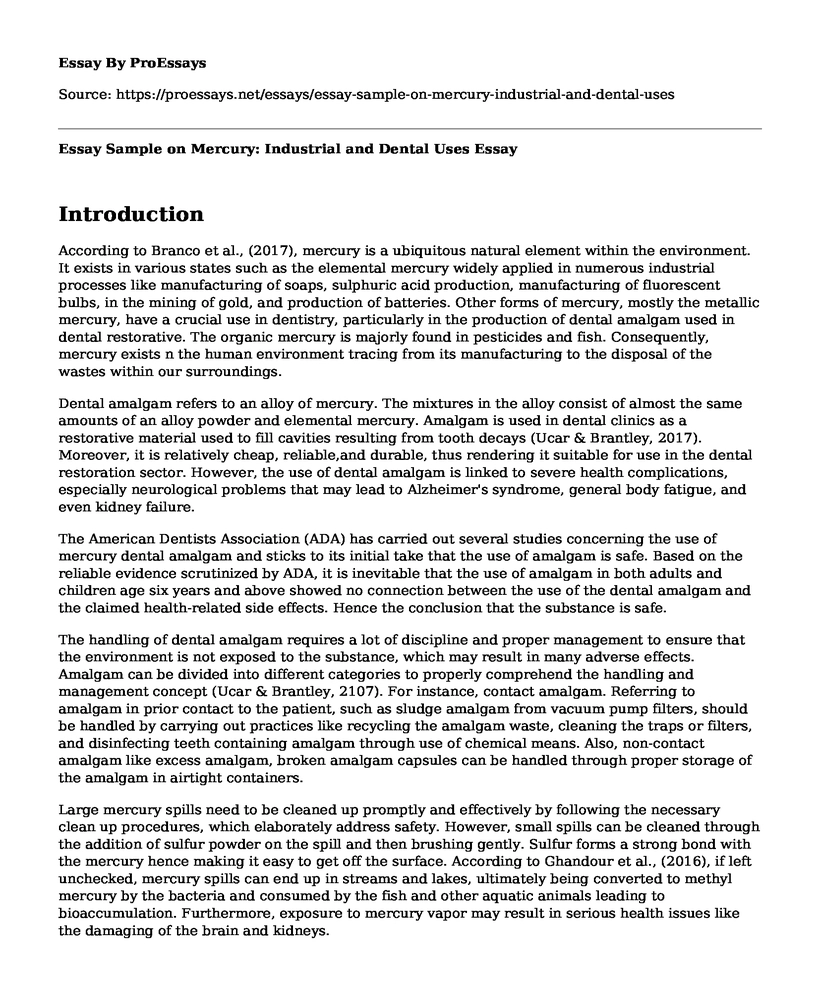Introduction
According to Branco et al., (2017), mercury is a ubiquitous natural element within the environment. It exists in various states such as the elemental mercury widely applied in numerous industrial processes like manufacturing of soaps, sulphuric acid production, manufacturing of fluorescent bulbs, in the mining of gold, and production of batteries. Other forms of mercury, mostly the metallic mercury, have a crucial use in dentistry, particularly in the production of dental amalgam used in dental restorative. The organic mercury is majorly found in pesticides and fish. Consequently, mercury exists n the human environment tracing from its manufacturing to the disposal of the wastes within our surroundings.
Dental amalgam refers to an alloy of mercury. The mixtures in the alloy consist of almost the same amounts of an alloy powder and elemental mercury. Amalgam is used in dental clinics as a restorative material used to fill cavities resulting from tooth decays (Ucar & Brantley, 2017). Moreover, it is relatively cheap, reliable,and durable, thus rendering it suitable for use in the dental restoration sector. However, the use of dental amalgam is linked to severe health complications, especially neurological problems that may lead to Alzheimer's syndrome, general body fatigue, and even kidney failure.
The American Dentists Association (ADA) has carried out several studies concerning the use of mercury dental amalgam and sticks to its initial take that the use of amalgam is safe. Based on the reliable evidence scrutinized by ADA, it is inevitable that the use of amalgam in both adults and children age six years and above showed no connection between the use of the dental amalgam and the claimed health-related side effects. Hence the conclusion that the substance is safe.
The handling of dental amalgam requires a lot of discipline and proper management to ensure that the environment is not exposed to the substance, which may result in many adverse effects. Amalgam can be divided into different categories to properly comprehend the handling and management concept (Ucar & Brantley, 2107). For instance, contact amalgam. Referring to amalgam in prior contact to the patient, such as sludge amalgam from vacuum pump filters, should be handled by carrying out practices like recycling the amalgam waste, cleaning the traps or filters, and disinfecting teeth containing amalgam through use of chemical means. Also, non-contact amalgam like excess amalgam, broken amalgam capsules can be handled through proper storage of the amalgam in airtight containers.
Large mercury spills need to be cleaned up promptly and effectively by following the necessary clean up procedures, which elaborately address safety. However, small spills can be cleaned through the addition of sulfur powder on the spill and then brushing gently. Sulfur forms a strong bond with the mercury hence making it easy to get off the surface. According to Ghandour et al., (2016), if left unchecked, mercury spills can end up in streams and lakes, ultimately being converted to methyl mercury by the bacteria and consumed by the fish and other aquatic animals leading to bioaccumulation. Furthermore, exposure to mercury vapor may result in serious health issues like the damaging of the brain and kidneys.
Conclusion
In conclusion, mercury is a natural element with numerous beneficial uses, especially within the industrial set up and the dentistry fields. However, its ability to act as a potent neurotoxin even in small amounts, calls for the need for careful use and disposal of the elemental mercury.
References
Branco, V., Caito, S., Farina, M., Teixeira da Rocha, J., Aschner, M., & Carvalho, C. (2017). Biomarkers of mercury toxicity: Past, present, and future trends. Journal of Toxicology and Environmental Health, Part B, 20(3), 119-154. Retrieved from https://www.tandfonline.com/doi/abs/10.1080/10937404.2017.1289834
Ghandour, L., Hafizi, K., Kichil, F., & Uran, S. (2016). Potential health effects of amalgam fillings: a structured literature review. Retrieved from https://ruor.uottawa.ca/handle/10393/35551
Ucar, Y., & Brantley, W. (2017). Biocompatibility of dental amalgams. In Biocompatibility of Dental Biomaterials (pp. 95-111). Woodhead Publishing.Retrieved from https://www.sciencedirect.com/science/article/pii/B9780081008843000072
Cite this page
Essay Sample on Mercury: Industrial and Dental Uses. (2023, May 07). Retrieved from https://proessays.net/essays/essay-sample-on-mercury-industrial-and-dental-uses
If you are the original author of this essay and no longer wish to have it published on the ProEssays website, please click below to request its removal:
- A Contemporary Nursing Leader: Dorothea Lynde Dix Paper Example
- Pharmaceutical Treatment of Hepatitis C Paper Example
- Should Parents Refuse Vaccines for Their Children? - Research Paper Example
- COVID-19: Global Pandemic With 166 Countries Affected - Essay Sample
- Research Paper on Bats & Viruses: The Spillover Effect & Coronavirus
- Structural Social Work Theory: Intervening Between Society & Individuals - Essay Sample
- Essay Sample on Diagnosing Mental Disorders: 2 Case Studies







